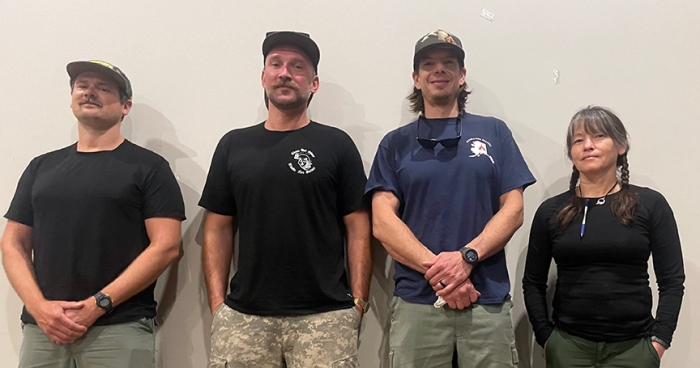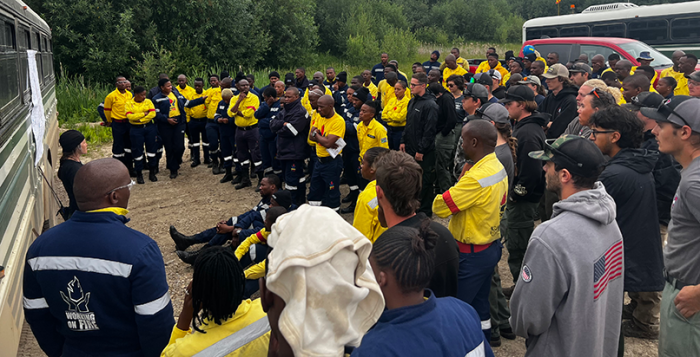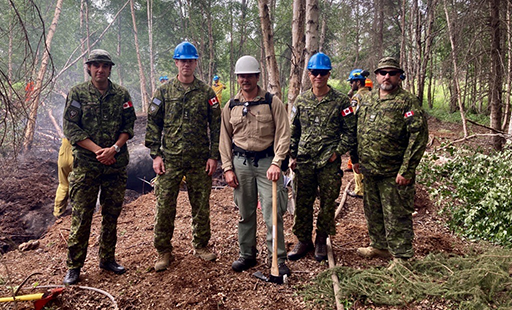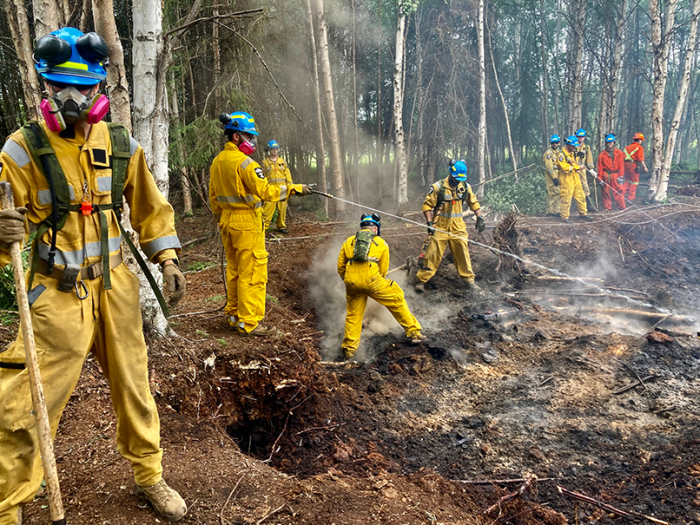BLM AFS firefighters talk about their part in the international effort during Canada’s devastating fire season
The extremely slow fire season has allowed Alaska firefighting and support personnel to help the international effort in Canada as it grapples with a historic and devastating fire season that doesn’t show signs of slowing.
The state may end the 2023 Alaska fire season with the least number of acres burned since records began in 1940. While Alaska has only had 157 wildfires burn 1,891 acres across the state as of Friday, July 21, 4,356 fires have scorched almost 28 million acres across Canada. In Alberta and British Columbia – which combined are almost as large as Alaska in square miles (620,305 to Alaska’s 665,400) – more than 2,000 wildfires have burned almost 8 million acres in the two Canadian provinces.
Wildfires have triggered evacuations, sent smoke far into the United States and devastated communities across Canada. Most notably are the two Canadian firefighters and helicopter pilot killed while working on incidents in Canada recently.
The international community has responded as the country enters its third month of extreme fire behavior. At least 13 countries have sent firefighting and support personnel with the U.S. contributing about 2,050 personnel, according to the National Interagency Fire Center in Boise. Of those, about 70 are from BLM Alaska Fire Service. Some are on their second fire assignment to Canada.
They’ve traveled to Alberta, British Columbia and Quebec, filling positions as liaisons for U.S. firefighting personnel, in operations, in the main Canadian forest fire warehouse, as smokejumpers, as part of an Alaska Interagency Incident Management Team and the two BLM AFS hotshot crews. You can find various photos of the BLM AFS personnel in Canada at the BLM AFS Flickr album here: https://flic.kr/s/aHBqjALYAV
The first wave of BLM AFS firefighters spent a majority of June in Alberta where they worked alongside their fellow firefighters from the various Canadian provinces, Australia and South Africa.
For them, they felt it was the most unique assignment they’ve had in their long firefighting careers and one they will cherish because of the cultural exchange they experienced.
Here are some of their stories.

Kay Kudo, BLM AFS Fire Specialist
Kudo started her daily morning briefings for the roughly 100 firefighters working on her section of the fire using salutations in both English, and for the four 20-person hand crews from South Africa, the Afrikaan greeting, “molo.” The diverse assembly of international firefighters would reply in unison, calling out in languages from English to Afrikaan, before Kudo dove into the daily tasks and objectives for that section of the Eagle Creek Complex in Alberta.
At the beginning of her two-week assignment in June, Kudo did a little research on the various cultures she’d be interacting with as a Division Supervisor overseeing the operational duties of a section of the fire.
In this role, she was responsible for the people and the on-the-ground tactical operations in an area that was closest to a community which had been heavily damaged by the fire. Her first priority was to make sure that all the personnel in her division and the people of nearby Fox Creek were kept safe.

To further complicate this monumental task, the different terminology, accents and slang used, prompted Kudo to go extra mile making sure everyone understood what was being communicated.
“It was a fascinating thing to be a part of, where you are literally trying to adapt to all the different cultures and do the best job you can,” she said. “Everyone feels that human connection if you take the time.”
“It was an interesting dynamic” because she went into the situation not knowing anyone on the fire and had to start from scratch in building trust and rapport with people she was working with. Because the American wildland fire community is very interconnected, she’s usually working with at least one familiar face during a typical fire assignment in the U.S. For most of this assignment, she was the only American firefighter operating in a supervisory position.
“I felt a lot of pressure representing my country and Alaska,” she said.
Because Kudo is very petite, she used a yard stick to help point to different parts of the map when giving her briefings, a prop she felt unfavorably represented school authority. This tool evolved into a yardstick wrapped in pink flagging, to random sticks, until one of the local Canadian firefighters custom-designed a pointer for her – a tent pole wrapped in purple pipe cleaner with a purple dog figurine attached to the end.

“I intend to use that pointer for the rest of my career,” Kudo said of the gesture.
It was an enriching experience due to the bonds she forged with the Australians, Canadians and South Africans she worked with, and her understanding that despite their different backgrounds and experiences, everyone was working toward the same goal.
“Everyone wants to do a good job,” Kudo said. “The first priority is to keep everyone safe; then to do our jobs well and to have fun.”

Joe Erickson, BLM AFS Military Zone Fire Specialist
While in Canada from June 13-29, Erickson was a Task Force Leader working on the Pembina Complex with firefighters from Australia, South Africa, and Canadians from the provinces of Yukon, British Columbia and Alberta. A Task Force Leader directs any combination of personnel or equipment performing tactical missions on incidents.
The highlight for him and the other AFS personnel was working with others from around the world. For Erickson, he especially enjoyed working with the South Africans who were “so happy and cheerful.”
“There were no egos. Everyone just got along,” he said. “It makes it easier to work when everyone is getting along.” This sentiment was echoed by others who recently came back from Canada.
He even recorded video of the South African firefighters singing and dancing while walking to and from the fireline.
Erickson said there were similarities between firefighting in Alaska and Alberta – they both have fire-adapted and fire-dependent ecosystems of the boreal forest with an abundance of black and white spruce, and duff – the partially decomposed organic ground layer beneath the litter of freshly fallen twigs, needles and leaves.
The dirty, time intensive process of finding hot spots is also the same. Erickson said it’s called “mopping up the muskegs” in Canada.
Both Alaska and Canada use the Canadian Forest Fire Danger Rating System to evaluate environmental factors such as wind, temperature, fuels, topography that influence ignition, spread and behavior of wildfires.
Yet there were some very big differences. Besides the use of the metric system and some distinct terminology, the Canadian water handling systems utilize a quarter-turn clip-on connection instead of the male to female hose ends used in the U.S. This was something Erickson saw as more efficient.
Erickson headed back to Canada for another fire assignment about two weeks after he returned from Alberta – this time going to British Columbia as a Firing Boss.
Justen Johansen, BLM AFS Fire Specialist
In the first part of his assignment, Johansen was a Task Force Leader for two Canadian Army crews, some heavy equipment and medics on the Deep Creek Complex. The crew was very concerned with respiratory health and wore what looked like paint respirators and masks as well as one-piece bright yellow fire-resistant suits.

He said they had the time consuming and exhausting job of mopping up hot spots in an agricultural area dominated by peat farms that were littered with “massive ash pits” after the fire moved through the area. To do this in peat that were sometimes 4- to 6-feet deep, they enlisted the help of an excavator and sprayed down with water pumped from an impressively large 40,000 liter, or 10,566-gallon, water tank parked at the site.

Not long after, a large rainstorm moved into the area and turned the ash pits into ponds. The Canadian Army was then released from its firefighting duties and Johansen moved into another Task Force Leader position. The new group comprised of three 20-person crews from South Africa, two Canadian 4-person helitack crews and three larger Canadian Firetack crews. He also filled in as a Division Supervisor for a few shifts while an Australian team took a few days off in between assignments on the fire.
Unlike the U.S. firefighters, last names were rarely used when referring to personnel on the fire. Instead, their nationality was tagged onto their first name so Justen was known as “Justen the American.”
There was a lot of emphasis placed on respect and dignity towards one another – especially since there were people from very different cultures working together. Johansen said he heard of two people that were demobilized from the incident just for “not being nice” to others working on the fire.
“It felt like the team I was working for put a lot of emphasis on inclusion,” he said. “There was a lot more emphasis on people’s behavior to maintain that friendly, pleasant vibe.”
The South African crews he worked with were “regularly singing and dancing while they were working.”
On June 16, the crews gave a performance in front of the entire camp to mark a South African holiday called Youth Day. This public holiday honors the students that were ambushed and killed while protesting the implementation of Afrikaan, a language with West Germanic origins, as the medium of instruction in black schools in the 1970s. The riots were a key moment in the fight against apartheid, the racial segregation policy in South Africa that wasn’t abolished until 1991. While the South Africans marched and sang for their international counterparts on the fire, someone translated and explained the significance of the ceremony.

During Johansen’s last working shift before returning to Alaska, the South Africans invited him and other firefighters to join them in a dance send off for their trip home. He jumped in the group along with a Canadian as they sang and danced.
Johansen headed back to Canada on Wednesday where he’s working in British Columbia as a Task Force Leader.
Categories: AK Fire Info, BLM Alaska Fire Service